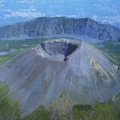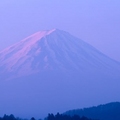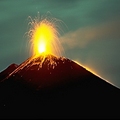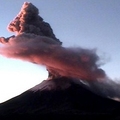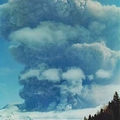Eco-friendly locations / The Best Volcanoes to Visit in the World / Soufriere Hills
Soufriere Hills
Soufriere Hills is a complex of volcanoes in the West Indies , located in the southern part of the island of Montserrat . After a long period of time the state of volcano was dormant, but it resumed its activity in 1995 and it continued to erupt since that time. The eruptions of this volcano made half of the island uninhabitable, destroying the capital city of Plymouth , and causing a mass evacuation. Two thirds of the population left the island.
History of eruptions
The seismic activity was observed on the island in 1897-1898, 1933-1937 and in the 1966-1967 years, but the eruption, which began on July 18, 1995 was the first since the XVII century. When mud flows became routine, the Plymouth was evacuated, and after few weeks the city was listed with several feet of ash. A major eruption took place on June 25, 1997 which resulted in the death of 19 persons. The airport of the island was on the way of the main stream and it was completely destroyed. Montserrat tourism industry was hit hard, but then began to recover in particular through the support from the UK . A strong eruption was on July 28, 2008 with no prior activity. The ends of the pyroclastic flows reached Plymouth. The height of the eruptive column was estimated at 12 km above the sea level. On February 11, 2010 was a partial collapse of the dome of the volcano.
Structure of the volcano
To register the eruption of the volcano, a special volcanic observatory was founded, which conducts detailed measurements and informs the government and the people of the island. The observatory is controlled by the British Geological Survey . Soufriere Hills Volcano has a height of 915 meters and it is composed primarily of andesite . The crater that was formed about 4 thousand years ago, collapsing the top, has a diameter of 1 km summit and consists of several volcanic domes . The current activity consists of a period of dome growth and dome collapses short, which lead to pyroclastic flows, ash emission and explosive eruptions. On October 9, 2008 in the journal " Science "has been suggested that two interconnected magma chambers were under the volcano - one at a depth of 6 km, the other - at a depth of 12 km.
POPULATION
There are approximately 5000 people, mostly negroes and mulattos. Most of the 11 thousand people living on Montserrat until 1989, emigrated to England, Canada, and the other islands of the West Indies from the devastating eruptions of the Soufriere Hills volcano.
GEOGRAPHY
The British possession in the West Indies in 1632 occupies the eponymous island in the group of the Lesser Antilles, in the Leeward Islands. This is the volcanic island of the three main volcanic massifs ( the highest point is the peak Chensis, 915 m). The Soufriere volcano, which is a group of volcanic hills, began erupting in July 1995 and it is always active to the present time. The total area of the island is of 102 square kilometers.
CURRENCY
The Eastern Caribbean dollar (EC $) is equal to 100 cents. U.S. dollars are also free to accept payment in all sectors of the economy. Currency exchange presents no difficulties, the most favorable terms of exchange at banks. All major credit cards and travelers' checks of the world's leading systems are accepted. To avoid additional losses in the conversion, it is recommended to use travelers' in the U.S. dollars tipping at a rate of 5-10% of the total bill (but not less than 3 dollars) in restaurants, taxi drivers and porters, as well as support staff at the hotels to 8,5%.
The main attraction of Montserrat
The main attraction of Montserrat has long been known as the "Emerald Isle of the West Indies." The residents of the island has always professed the original "Caribbean Way", implying a relaxed and leisurely way of life based on Christian traditions and commandments. Because of the island attachment to traditional values and a certain restraint in communication, which seemed to many tourists, even prudish, the island had an unofficial title of "Little England". The island is also always welcomed to rest - "calm" and low mountainous interior, a few interesting historical sites and charming beaches of black volcanic sand - all this created a unique flavor. Raised from the seabed huge planetary changes, volcanoes have left the island with fertile soil, that a lot of green forests and emerald-green fields are home to countless birds and animals, and water around inhabited by many species of marine life. Abundant flora such as the yellow hibiscus, blood-red and golden canna allamandy, cover rocks and climbing the side of roads. The rock walls and the old lava fields shimmer colors as bright as the surrounding bush. The unique black beaches are already so "fused" with the image of Montserrat that a single white beach in the Bay Rendezvous is more like a miracle. The Government of Montserrat has never intended to turn the island into an object of mass tourism, so most of the attractions of the island were so popular now in the "wild" form. However, the eruption of the Soufriere Hills have created permanent difficult conditions to travel to the island, most of them will likely remain in pristine conditions for a long time. For example, "The Great Alpine waterfall", formerly one of the most exciting attractions in the West Indies, was completely destroyed by the volcanic activity, but strong resort towns of the island, consisting of luxury villas and cottages facing directly on the shores of the beaches, cover with a layer of volcanic ash up to 5 cm or more. Nevertheless, the island is visited annually by 40 000 foreign tourists providing $ 10 million in revenue. Hiking is one of the most advanced forms of recreation on the island. The most popular tours are organized in the gorgeous forest of Montserrat, with a wide range of organized tours and hiking trails, mostly in the north. Popular routes: Cote-Trail, which passes through an old banana plantation to the historic estate of the family Cote Ghaouth-wound, passing through the central hills, or Silver Hill Trail, which crosses one of the oldest volcanic massifs of the island. Tours directly in the area of volcanoes are also available. Experienced guides lead visitors through a predominantly absolutely safe haven from which to observe the activities of the Soufriere Hills with a completely safe distance. Most of the residences in non-affected areas have their own swimming pools or directly go to the beach of black volcanic sand. The Rental of Villas offers the most freedom in choosing how to rest, and also guarantees the absolute safety of both the activity of the volcano, and from the exposure to hazardous marine life, such as houses, usually built in a carefully inspected the ground and provided with all modern conveniences. The surrounding waters are excellent for snorkeling. And the deep and "small" dive is totally accessible, and the equipment is available to rent or to buy right on the island. The equipment is also easily accessible in the main resort areas. A diving experience is guaranteed. The local waters are considered among the best in the world on a variety of underwater inhabitants and the underwater landscape. One of the "business cards" of the island has always been sea fishing. Travelling to the beautiful sea for the local fish can be arranged at any hotel or directly from tour operators as well as the lack of any boats and yachts. The island's capital, Plymouth, which is to enhance the volcano was one of the most popular tourist ports and had an attractive "Indian" flavor, but now has become quite a ghost town. These clouds are precipitating it from the middle of 1997 volcanic ash and turned its once flourishing famous Caribbean streets like those in Pompeii. The city is still rich in historic mansions and the finest examples of architectural styles, but its once-bustling port and different hotels are almost "extinct."
Maps of Soufriere Hills
map MontserratOthers from The Best Volcanoes to Visit in the World
A volcano is formed by a non-visible internal structure of the crust including magma chamber , magma pipes and a visible structure.
More commonly, the term volcano refers only to the outside and the visible part to the right of the volcanic relief , more or less conical, consisting of all those materials, liquid, solid or gaseous fuels, which were issued from the craters during the various stages of the eruption of the volcano itself.
The masses of rocks which form a volcano are called igneous rocks , as derived from the cooling of the magma ascended from the Earth .
The shape and the height of a volcano depend on several factors including the age of the volcano, the type of the eruptive activity, the type of the released magma and the characteristics of the underlying volcanic structure.
In general volcanoes are discontinuities in the Earth's crust through which all various events and magmatic endogenous products: powders, gases, vapors and solid volcanic material is casted.
The release of this material is erupting and the erupted materials are lava , ash , gas , slag and various water vapors .
On the surface, 90% are submarine volcanoes (mostly located along the dorsal mid-ocean), while about 1500 volcanoes are now active on land.
Description What is commonly called a volcano, technical terminology is defined in the volcano or volcanic cone , but since the term most used is the volcano.
The volcano is often named in geology .
The volcanoes testify to the existence, in the deep zones of the lithosphere , the molten masses of silicate are called natural magmas .
A generic volcano is formed by: a magma chamber or a magma basin, fed by magma , when it is empty after an eruption.
A volcano may collapse and create a caldera .
The magma chambers are located between 10 and 50 km depth in the lithosphere .
a stack or a duct volcanic main crossing point of the magma from the magma chamber to the surface.
a crater summit, where the main pipe flows.
one or more secondary ducts, which, flowing from the flanks of the volcano or the same basis, give life to the secondary cones.
lateral cracks, fractures on the longitudinal side of the volcano, caused by the pressure of the magma.
They allow the escape of lava in the form of eruption.
For their grandeur of the event the volcanoes are an object of admiration, of fear, of curiosity and of study since the antiquity with different interpretations created to explain its origin.
Plato admitted the existence of an underground river of fire.
Seneca indicated as the cause of eruptions and earthquakes, the penetration of water into the ground, when the water reached the incandescent matter, vapors under high pressure.
In 79 AD ,Pliny the Younger described the eruption of Vesuvius that buried Pompeii , Herculaneum and Stabiae.
But the real science that studies volcanoes, the volcanology ,was born only in the seventeenth century , when the naturalists were interested in the eruptions of Vesuvius ( in 1631 ) and of Etna ( in 1669 ).
This science is more decisive in progress with the studies of Spallanzani and then in the nineteenth century , with the help of petrography .
The origin of volcanoes is explained by various theories, including two important, but opposite theories: the theory of craters of lifting De Buch ; the theory of external accumulation of Scrope and Spallanzani .
In the theory of De Buch, volcanoes would have originated from the magma which would raise the outer layers of the Earth forming the cone, which then would break up to form the craters.
In the second theory, the volcanoes would be due to the accumulation of the solid material emitted or projected from the volcanic conduit.
The heat that is produced inside exerts a pressure evenly over the crust, thinner where the magma would surrender, letting it , causing the birth of the volcanoes.
The classification of volcanoes The volcanoes can be classified according to the type of external device or the type of the volcanic eruptions, both of these characteristics being closely linked to the composition of the magma and the magma chamber (and thus emitting lava).
This classification is called Lacroix Classification by the French geologist Alfred Lacroix who first conceived.
Depending on the type of the volcanic external apparatus Considering the type of the volcanic cone there are 2 types of volcanoes: 1.
Shield volcanoes 2.
Cone volcanoes Shield volcanoes A shield volcano has moderately sloping sides, and it is built by the eruption of the lava basalt fluid.
The basaltic lava tends to build enormous cones low slope, because its low viscosity allows it to slide smoothly on the ground or under it, in the lava tubes, up to many kilometers without significant cooling.
The major volcanoes of the world are the shield volcanoes.
The name comes from the same geometry, which makes them look like shields resting on the ground.
The largest shield volcano in the world is in Hawaii , its name is Mauna Loa .
It measures about 4000 m above the sea level , but its base is located at 5000 feet below the sea level, so its actual height is of 9000 meters, while its base diameter is about 250 km.
Cone volcanoes We find a volcano cone when the lava is acidic.
In these cases, the magma is very viscous and it is difficult to trace, solidifying quickly once outside.
Emissions flow and alternate with the solid material that is shot out and alternate with the cast, as the layers of the building.
The eruptions of this type can be very violent (like that of Vesuvius that buried Pompeii ), because the magma tends to obstruct the volcanic chimney creating a "cap" only when the internal pressures are sufficient to overcome the obstruction, the eruption resumed ( the eruption of Vulcan type), but in extreme cases there may be an explosion that may come to destroy the entire volcano ( Peleus).
The volcanism of this type is present along the continental margin of the pits or arc-trench systems, where the magma comes from the crust where the rocks are more of an exogenous composition.
Depending on the type of the eruptive activity Broadly speaking we distinguish red volcanoes (volcanoes characterized by effusive emissions in which the accumulation of the volcanic lava flows gives the building looks "reddish brown"), and gray volcanic (eruptions of volcanoes with explosive character in which the accumulation of ash give the building looks gray-black volcanic).
Specifically, considering the type and the power of the eruption of a volcano you have: 1.
Hawaiian volcanoes in eruption type 2.
Volcanoes in eruption of Icelandic type 3.
Strombolian volcanoes in eruption type 4.
Volcano eruption at Vulcan type 5.
Volcano eruption at Vesuvius type 6.
Plinian eruptions at volcanoes and Pelean type 7.
Large calderas ("super-volcanoes") Hawaiian Type The eruptions are not related to the tectonic movements that are due to the plaque but rather to see the phenomena the magma plumes from the back to warm up the hot spots.
The summit of the volcano is occupied by a large depression called caldera , bounded by steep walls due to the collapse of the fund.
Others occur within the caldera collapses, creating a well structure .
The lava is very basic and therefore very fluid, it produces the typical volcanic edifices form a "shield , with weak slopes of the mountains.
Icelandic type They are also called volcanic fissure eruptions which occur through long slits and not by a circular crater.
The casting, basic and the ultra basic magmas fed by, tend to form the highland basalt (basalt plateaus).
At the end of an eruption fissure (or linear), the eruptive fissure may disappear since it is covered by lava and solidified spill, does not reappear until the next eruption.
The best examples are found in Iceland , from which the special designation of the type, an excellent example of the Icelandic volcano eruption is that of Laki of 1783 , one of the most famous volcanic eruptions in the history of the European Union .
Strombolian type Very viscous basaltic magmas give rise to an enduring characterized by emissions at regular intervals and fragments of lava fountains that reach hundreds of meters high, and the launch of lava and volcanic bombs.
The fallout of these products creates scoria cones from the quite steepides .
Stromboli , the island-volcano from which it takes its name, this kind of effusive activity, has been in business for two millennia, much to be known, since the time of the earliest civilizations as the " lighthouse of the Mediterranean .
" Type Vulcan They were named after the island of Vulcano in the archipelago of the Aeolian Islands .
They are explosive eruptions during which lava bombs release clouds of gas and ash laden.
The explosions can produce fractures, ruptures of the crater and the opening of lateral vents.
Vesuvius type From the name of the volcano Vesuvius , it is similar to the Vulcan, but with the difference that the initial explosion is tremendously violent enough to drain most of the magma chamber: the magma from deep zones, then back up at high speed out of the crater and dissolve in tiny droplets.
When this type of eruption is at its most violent it is called Plinian eruption (in honor of Pliny the Younger who first described the course in 79 AD).
Plinian type The eruptions are produced by very viscous magma .
Hot clouds are frequently formed from gas and pulverized lava.
They are very dangerous eruptions ending usually with partial or total collapse of the volcano or the release of a plug of lava that of a volcanic plug or dome .
In some cases both phenomena occur.
The volcanic eruption that exhibits this behavior are characterized by the shape of a cone.
These eruptions are named for Pliny the Younger who first described this type of eruption observing the eruption of Vesuvius in 79 AD, which submerged Pompeii and Herculaneum in ashes .
A variant is the Plinian eruption : if during a Plinian eruption the main body of the glowing cloud released from the crater summit during an eruption peleana (which takes its name from the volcano 's Pelee in Martinique ) , the volcano erupts from the crater, but not centrally splitting up the side of the volcano.
This eruption has devastating effects concentrated in the direction of the main eruption of a glowing cloud that can reach more than 20 km from the building volcanic (as happened in 1980 in the eruption of St.
Helens ).
Other variants of the Plinian eruptions are the ultra-plinian : these eruptions are characterized for having an even bigger explosion, which may come to completely destroy the volcanic edifice (it is an example of the Krakatoa or Santorini ), and above all for the enormous amount of the released volcanic ash.
The explosion of this type, based on the large amount of ash that remains in suspension in the atmosphere, has a greater or lesser impact on the global climate in the years following the eruption.
Large calderas Although not recognized as true volcanoes, they deserve a separate mentioning: the case of 7-8 large calderas identified on the surface.
These structures are characterized by not having a volcano rather than a depression of volcanic origin (known as Caldera), which covers a vast area, more than 10-15 km.
Inside the caldera, you can see the development of various craters formed more or less.
It was never observed an eruption of this type of calderas (which have periods of eruption of hundreds of thousands of years) and these areas are now subject only to a minor type of volcanism (geysers, fumaroles, hot springs, .
.
.
).
The best known examples of this type of equipment is the park of Yellowstone , The Phlegraean Fields , the Alban Hills , the Toba Lake .
Activities of volcanoes The magma rises through the mantle or less dense than the Earth's crust because of the surrounding rocks (lifts for buoyancy ).
During the ascent, due to the decrease in pressure , the gases dissolved in the melt dissolve a further decrease of the density .
The magma in the crust can build up, to cool and solidify, or climb up to the surface of the earth thus giving rise to an eruption .
The eruptions may be of different types: they can give rise to explosive phenomena, where ash and lapilli are projected up to tens of kilometers above the crater and deposited up to hundreds of miles away from the eruptive center, or effusive, if the magma flows, forming a lava flow that propagates to shorter distances (tens of meters to a few km from the eruptive center).
One of the characteristics that influences the type of the eruption is the viscosity of the magma, which depends on the content of silicon , which binds with the oxygen molecules that form always tend to bond with each other and form indestructible chains.
If the magma has more than 60% silica [SiO2] it is considered viscous and more likely to give rise to an explosive eruption, but if the magma has less than 50% silica it is likely to be erupted with dynamic and effusive emitted lava as flows.
Here is a presentation of the most famous and the most popular volcanoes in the world.
Of course, I referred to their power of eruption, their activity and their beautiful environment provided to visitors.
Volcanoes represent huge interest to people, not only for the fact that they are dangerous but for many other reasons too.
Discover the most famous volcanoes in the world.

